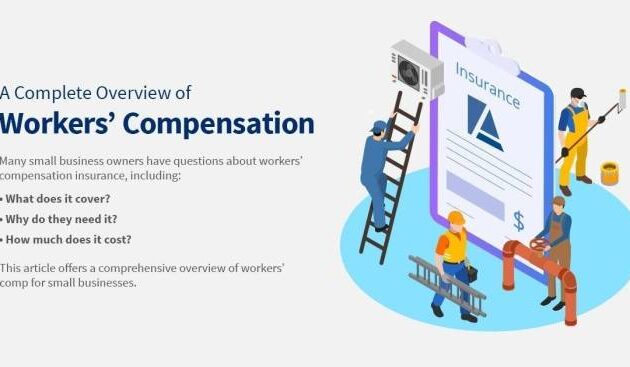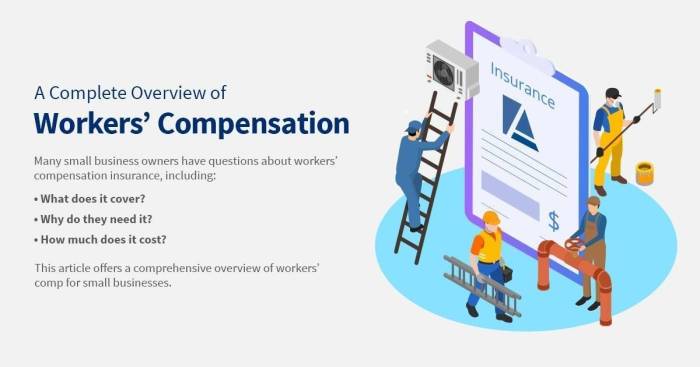
The world of work comp insurance companies is a complex tapestry woven from legal obligations, financial considerations, and the human element of workplace safety and well-being. Understanding this landscape is crucial for both employers, striving to protect their workforce and manage costs, and employees, seeking assurance of fair compensation in the event of workplace injury. This exploration delves into the diverse types of work comp insurers, their coverage models, the claims process, and the ever-evolving regulatory environment that shapes this critical industry.
From the intricacies of premium calculations to the evolving impact of technological advancements and legislative changes, this overview aims to provide a clear and comprehensive understanding of the factors influencing work comp insurance. We’ll examine how various business models, company sizes, and industry trends shape the services provided and the experiences of both policyholders and claimants.
Types of Work Comp Insurance Companies
Workers’ compensation insurance is a crucial aspect of employee protection, and the companies providing this coverage operate under diverse models. Understanding these models is essential for businesses seeking the best fit for their needs. This section will explore the different types of work comp insurance companies, highlighting their key distinctions and implications for policyholders.
State-Funded vs. Private Work Comp Insurance Providers
State-funded workers’ compensation insurance programs are government-run systems that provide coverage directly to employers. These programs typically offer a standardized set of benefits and are designed to ensure access to coverage for all businesses, regardless of size or risk profile. Private work comp insurance providers, on the other hand, are commercial entities that compete to offer coverage. They offer a wider range of policy options and services, often tailored to the specific needs of individual businesses. The key difference lies in the ownership and operational structure; state-funded programs are non-profit and government-regulated, while private insurers are profit-driven and subject to market forces.
Business Models of Work Comp Insurance Companies
Several business models underpin the operations of work comp insurance companies. Mutual insurance companies are owned by their policyholders, who share in the profits (or losses). Stock insurance companies are publicly traded corporations whose shareholders own the company and receive profits. Captive insurance companies are subsidiaries of larger corporations, providing coverage primarily to their parent company and affiliated businesses. These models affect the financial stability and risk tolerance of the insurer, ultimately influencing the premiums and services offered to policyholders. For instance, mutual companies may prioritize long-term relationships and lower premiums, while stock companies might focus on maximizing shareholder returns.
Impact of Company Size on Services Offered
The size of a work comp insurance company significantly impacts the range and quality of services it can offer. Larger companies often have more resources to invest in technology, claims management systems, and loss prevention programs. This translates to better customer service, faster claim processing, and more comprehensive risk management support for policyholders. Smaller companies may offer more personalized attention but might lack the resources for sophisticated risk management tools or extensive claims support networks. The optimal choice depends on the specific needs and resources of the business.
Comparison of Major Work Comp Insurance Companies
The following table compares four major work comp insurance companies, considering their market share and geographic focus. Note that market share data can fluctuate and precise figures vary depending on the source and year. This table presents a snapshot based on publicly available information.
| Company Name | Approximate Market Share (Illustrative) | Geographic Focus | Notable Services |
|---|---|---|---|
| Liberty Mutual | High (varies by state) | National | Extensive loss control programs, robust online portal |
| State Farm | High (varies by state) | National | Strong reputation, wide agent network |
| The Hartford | High (varies by state) | National | Specialized expertise in various industries |
| AmTrust Financial | Moderate (varies by state) | National | Focus on niche markets |
Policy Coverage and Claims Processes

Understanding the coverage provided by workers’ compensation insurance and the claims process is crucial for both employers and employees. This section Artikels the standard components of most policies and details the procedures involved in filing and resolving claims.
Most work comp insurance policies cover a range of expenses related to work-related injuries or illnesses. The specific coverage can vary depending on the state and the specific policy, but generally includes medical benefits, wage replacement (indemnity benefits), and death benefits in the event of a fatal workplace accident.
Standard Coverage Components
Standard work comp policies typically include coverage for medical expenses, lost wages, and death benefits. Medical benefits cover the costs associated with treating work-related injuries or illnesses, including doctor visits, hospital stays, surgery, physical therapy, and prescription medications. Indemnity benefits, or wage replacement, provide a portion of the employee’s lost wages while they are unable to work due to their injury or illness. Death benefits provide financial support to the dependents of an employee who dies as a result of a work-related injury or illness.
Types of Claims and Filing Procedures
Work compensation claims fall into three main categories: medical, indemnity, and death benefits. Each type of claim has a specific filing procedure. Timely and accurate reporting is essential for a smooth claims process.
Medical claims cover the costs of medical treatment for work-related injuries or illnesses. Employees typically need to seek treatment from a physician approved by the insurer. The physician then submits bills directly to the insurance company. Indemnity claims cover lost wages. Employees must typically provide documentation of their lost wages and the inability to work due to their injury. Death benefit claims are filed by the dependents of a deceased employee, requiring documentation of the relationship to the deceased and proof that the death was work-related.
Investigating and Resolving Disputed Claims
Disputes can arise in work compensation claims regarding the cause of the injury, the extent of the disability, or the amount of benefits owed. Insurance companies usually conduct thorough investigations, gathering evidence such as medical records, witness statements, and employer records. If the dispute cannot be resolved informally, it may proceed to a hearing before a workers’ compensation board or administrative law judge. The decision of the board or judge is generally binding on both parties.
Claimant’s Steps to File a Work Comp Claim
The process for filing a work comp claim can vary slightly by state, but generally follows these steps. A clear understanding of these steps can help ensure a smoother process.
A flowchart depicting this process would visually represent the following steps:
Step 1: Report the Injury – The employee immediately reports the injury or illness to their supervisor. This is a critical first step, triggering the official claim process.
Step 2: Seek Medical Attention – The employee seeks medical treatment from a designated physician or healthcare provider. This is crucial for documenting the injury and its treatment.
Step 3: Complete Claim Forms – The employee completes necessary claim forms provided by their employer or the insurance company. Accurate and complete information is essential.
Step 4: Submit Supporting Documentation – The employee submits supporting documentation, including medical records, witness statements, and employment information.
Step 5: Insurance Company Review – The insurance company reviews the claim and supporting documentation to determine eligibility and benefits.
Step 6: Benefits Determination – The insurance company determines the type and amount of benefits to be paid.
Step 7: Payment of Benefits – The insurance company begins paying approved benefits.
Step 8: Ongoing Communication – The employee maintains ongoing communication with the insurance company and their healthcare provider regarding their progress.
Step 9: Dispute Resolution (if necessary) – If a dispute arises, the employee follows the established dispute resolution process.
Cost Factors and Premium Determination
Understanding the factors that influence workers’ compensation insurance premiums is crucial for businesses to effectively manage their risk and budget. Premiums aren’t arbitrary; they reflect a complex assessment of the likelihood of workplace accidents and the potential costs associated with them. This section details the key elements that determine the cost of work comp insurance.
Key Factors Influencing Work Comp Premiums
Several interconnected factors significantly influence the cost of workers’ compensation insurance premiums. These factors are considered by insurers during the risk assessment process, ultimately determining the premium a business will pay. The most significant factors include the employer’s industry classification, claims history, and employee demographics. Industry classification reflects the inherent risk associated with specific types of work. For example, construction typically carries higher premiums due to the increased risk of injury compared to, say, an office setting. Claims history directly impacts premiums; a history of frequent or costly claims results in higher premiums as it indicates a higher risk profile. Employee demographics, including age, gender, and occupation, also play a role, as certain demographics are statistically associated with higher injury rates. Furthermore, the number of employees and payroll directly influence premium calculations as these figures are fundamental to the risk assessment. Finally, the state in which the business operates plays a significant role because state regulations and laws vary widely, affecting both the cost of claims and the overall premium structure.
Risk Assessment and Premium Setting Methods
Insurers employ various methods to assess risk and set premiums, all aiming to accurately reflect the likelihood and potential cost of future claims. A primary method involves using statistical data and actuarial modeling to analyze historical claims data for similar businesses within the same industry classification. This data helps to establish a baseline risk profile. Insurers also conduct on-site risk assessments to evaluate workplace safety practices and identify potential hazards. These assessments involve examining safety procedures, equipment, and the overall work environment. The findings from these assessments are crucial in refining the risk profile and adjusting the premium accordingly. Furthermore, insurers often use sophisticated algorithms and predictive modeling to analyze various factors and generate a more precise premium calculation. These models consider not just historical data but also forward-looking factors, such as predicted economic conditions and industry trends.
Comparison of Work Comp Rating Systems
Different rating systems are used in the work comp insurance industry, each with its own approach to calculating premiums. While the specifics vary by state and insurer, common approaches include experience rating, which focuses on the employer’s past claims experience, and schedule rating, which assesses the individual risks within a specific workplace and adjusts the premium based on implemented safety measures. Experience rating directly rewards businesses with a strong safety record by offering lower premiums, while schedule rating incentivizes improvements in workplace safety by offering premium discounts for adopting specific safety measures. A third approach, classification rating, assigns businesses to specific industry categories based on their risk profile. This method utilizes industry-wide statistical data to determine base premiums, with adjustments made based on individual employer characteristics. These systems, though different in approach, all aim to fairly reflect the risk posed by a particular business and encourage the implementation of effective safety measures.
Impact of Workplace Safety Measures on Premiums
Implementing effective workplace safety measures can significantly reduce work comp insurance premiums. The following table illustrates this impact:
| Safety Measure | Premium Impact | Example | Potential Savings (%) |
|---|---|---|---|
| Comprehensive Safety Training | Significant Reduction | Regular training on hazard identification and safe work practices. | 5-15% |
| Improved Ergonomics | Moderate Reduction | Ergonomic workstation assessments and adjustments to prevent musculoskeletal injuries. | 3-8% |
| Regular Safety Audits | Moderate Reduction | Proactive identification and mitigation of hazards through regular inspections. | 2-7% |
| Implementation of Safety Equipment | Moderate to Significant Reduction | Providing and enforcing the use of appropriate personal protective equipment (PPE). | 5-15% |
Industry Trends and Regulations

The workers’ compensation insurance industry is in constant flux, shaped by technological advancements, evolving legal landscapes, and shifting demographics in the workforce. Understanding these trends and regulations is crucial for both insurers and employers to navigate the complexities of providing and securing adequate coverage. This section will explore some key aspects of this dynamic environment.
Telehealth and Technology in Workers’ Compensation
The integration of telehealth and various technological advancements is significantly altering the workers’ compensation landscape. Telemedicine platforms allow for quicker access to medical professionals for injured workers, potentially reducing the time lost from work and lowering overall costs. Furthermore, sophisticated data analytics tools are enabling insurers to better assess risk, predict claim costs, and develop more targeted prevention programs. For example, wearable technology can monitor employee activity and identify potential ergonomic risks before injuries occur, leading to proactive interventions and reduced claim frequency. The use of AI in claims processing is also streamlining the process, leading to faster payouts and improved efficiency.
Recent Regulatory Changes Affecting Work Comp Insurance
Several states have recently implemented significant changes to their workers’ compensation laws. These changes often focus on issues such as opioid prescription limits, the expansion of telehealth services within the workers’ compensation system, and adjustments to benefit levels. For instance, some states have introduced stricter guidelines for prescribing opioids to injured workers to combat the opioid crisis. Others have legalized the use of cannabis for medical purposes, leading to debates and evolving regulations surrounding its coverage under workers’ compensation. These legislative shifts necessitate constant adaptation from insurance providers to maintain compliance and provide appropriate coverage within the new legal framework.
The Role of State Regulatory Bodies
Each state maintains its own regulatory body responsible for overseeing workers’ compensation insurance companies operating within its borders. These bodies, often a state’s Department of Insurance or a similar agency, play a critical role in ensuring fair practices, protecting policyholders’ rights, and maintaining the financial stability of the insurance market. Their responsibilities include licensing insurers, reviewing rate filings, investigating complaints, and enforcing compliance with state regulations. They also set standards for claims handling and ensure that insurers adhere to established guidelines. The actions of these regulatory bodies directly impact the availability and cost of workers’ compensation insurance within each state.
The Gig Economy and its Influence on Work Comp Coverage
The rise of the gig economy presents unique challenges to the traditional workers’ compensation system. Independent contractors and freelancers, often classified as 1099 employees, are typically not covered under standard employer-sponsored workers’ compensation policies. This leaves a significant portion of the workforce vulnerable to financial hardship in the event of a work-related injury. As a result, there’s a growing discussion and debate surrounding the need for alternative coverage models to protect gig workers. Some states are exploring legislation that mandates coverage for certain categories of gig workers, while others are promoting the adoption of voluntary insurance programs. The ongoing evolution of the gig economy will continue to shape the future of workers’ compensation insurance.
Customer Service and Policyholder Experience
Providing exceptional customer service is paramount for work comp insurance companies. A positive policyholder experience fosters loyalty, reduces churn, and ultimately contributes to the company’s success. This section explores the various aspects of customer service in the work comp insurance industry, examining best practices and highlighting key differentiators among providers.
Work comp insurance companies offer a diverse range of customer service options tailored to meet the needs of their policyholders. These typically include phone support, email communication, online portals with self-service functionalities, and in some cases, dedicated account managers for larger clients. Many companies are increasingly leveraging digital tools like chatbots and mobile apps to provide readily available assistance and information. The availability and responsiveness of these channels significantly influence the overall customer experience.
Customer Inquiry and Complaint Handling Best Practices
Effective handling of customer inquiries and complaints is critical for maintaining a positive reputation and building trust. Best practices include prompt responses, empathetic communication, clear explanations of processes and decisions, and proactive follow-up to ensure resolution. For example, a company might implement a system for tracking complaints, assigning them to dedicated personnel, and setting clear deadlines for resolution. Regular feedback surveys can also identify areas for improvement in customer service processes. A company known for its responsiveness and willingness to address concerns will generally enjoy higher customer satisfaction.
Customer Experience Comparison Across Providers
The customer experience can vary significantly across different work comp insurance providers. Some companies are known for their personalized service, offering dedicated account managers and proactive communication, while others may prioritize efficiency and cost-effectiveness, potentially leading to a less personalized but faster service experience. Factors like the size of the company, its technological capabilities, and its overall customer service philosophy all contribute to the variation observed in customer experiences. For example, a smaller, regionally focused insurer might provide more personalized service than a large national provider, but the national provider might offer more advanced online tools.
Key Characteristics of Excellent Customer Service in the Work Comp Insurance Industry
Excellent customer service in the work comp insurance industry is characterized by several key features. These go beyond simply answering questions; they involve building a relationship of trust and support with the policyholder during what can often be a stressful time.
- Responsiveness: Prompt and efficient response to inquiries and complaints.
- Empathy and Understanding: Demonstrating understanding of the policyholder’s situation and concerns.
- Clarity and Transparency: Providing clear and easy-to-understand explanations of policies, processes, and decisions.
- Proactive Communication: Keeping policyholders informed of important updates and changes.
- Accessibility: Offering a variety of convenient communication channels (phone, email, online portal, etc.).
- Problem-Solving Skills: Effectively addressing and resolving customer issues and concerns.
- Follow-up: Ensuring that issues are fully resolved and that the policyholder is satisfied.
Impact on Employers and Employees

Work compensation insurance significantly impacts both employers and employees, creating a balance between workplace safety and financial responsibility. Understanding these impacts is crucial for fostering a safe and productive work environment.
Benefits of Adequate Work Comp Insurance for Employers
Adequate workers’ compensation insurance offers numerous advantages for employers. It provides crucial financial protection against the potentially crippling costs associated with workplace injuries or illnesses. This includes medical expenses, lost wages, and legal fees. Beyond the financial benefits, it fosters a safer work environment by incentivizing proactive safety measures. A strong safety record can lead to lower premiums, demonstrating a return on investment in safety initiatives. Furthermore, having adequate work comp insurance enhances an employer’s reputation and can improve employee morale, leading to increased productivity and retention. The peace of mind it provides allows businesses to focus on core operations rather than worrying about the financial fallout of workplace incidents.
Employee Rights and Responsibilities Regarding Work Comp Insurance
Employees have specific rights and responsibilities concerning workers’ compensation. Employees have the right to file a claim for workplace injuries or illnesses regardless of fault. They are entitled to receive medical treatment and wage replacement benefits as Artikeld by their state’s workers’ compensation laws. However, employees also have responsibilities. They are generally required to report workplace injuries promptly to their employer. They must cooperate with the medical treatment process and participate in any rehabilitation programs offered. Failing to fulfill these responsibilities can jeopardize their eligibility for benefits. Understanding these rights and responsibilities is vital for ensuring a fair and efficient claims process.
Consequences for Employers Failing to Secure Adequate Work Comp Insurance
The consequences for employers who fail to secure adequate workers’ compensation insurance can be severe. Penalties vary by state but often include substantial fines and potential legal action. More importantly, employers without adequate coverage leave themselves financially vulnerable in the event of a workplace injury or illness. They become personally liable for all medical expenses, lost wages, and legal costs associated with the incident. This can lead to significant financial hardship and even business closure. Furthermore, failing to comply with workers’ compensation laws can damage an employer’s reputation and lead to negative publicity. This can affect their ability to attract and retain employees, ultimately impacting the long-term success of the business.
Comparison of Impact on Employer Costs vs. Employee Well-being
The relationship between employer costs and employee well-being concerning work comp insurance is complex but ultimately interconnected. While adequate insurance initially represents a cost to the employer, it ultimately contributes to a healthier and more productive workforce.
| Factor | Impact on Employer Costs | Impact on Employee Well-being | Overall Impact |
|---|---|---|---|
| Adequate Work Comp Insurance | Higher initial premiums, potential for safety investments | Access to medical care, wage replacement, reduced financial stress, improved safety | Potentially higher short-term costs, but long-term benefits through reduced litigation, improved employee morale and productivity. |
| Inadequate Work Comp Insurance | Potentially lower initial premiums, but significantly higher costs in case of workplace incidents (lawsuits, medical expenses, etc.) | Lack of access to adequate medical care, financial hardship, potential for long-term health issues due to lack of treatment, decreased job security. | Short-term cost savings may result in catastrophic long-term financial and reputational damage for the employer, significantly impacting employee well-being. |
Conclusion
Ultimately, the effectiveness of work comp insurance hinges on a delicate balance between responsible risk management by employers, efficient claims processing by insurers, and the equitable protection of employees’ rights. Navigating the complexities of this system requires awareness of the various players, their roles, and the regulations that govern their actions. By understanding the key elements discussed here—from policy coverage and cost factors to industry trends and customer service—employers and employees alike can better navigate this essential aspect of the modern workplace.
FAQ Resource
What happens if my employer doesn’t have work comp insurance?
In most jurisdictions, employers are legally required to carry workers’ compensation insurance. Failure to do so can result in significant penalties, including fines and potential legal action from injured employees.
How long does a work comp claim typically take to process?
The processing time for a work comp claim varies depending on the complexity of the case and the insurer’s efficiency. Simple claims might be resolved relatively quickly, while more complex cases involving significant injuries or disputes can take considerably longer.
Can I choose my own doctor for a work comp injury?
The process for choosing a doctor for work comp treatment varies by state and insurer. Some insurers may have a preferred provider network, while others allow more flexibility in choosing a physician. It’s crucial to check your policy and state regulations.
What types of injuries are typically covered by work comp insurance?
Work comp insurance generally covers injuries or illnesses that arise out of and in the course of employment. This includes accidents, repetitive strain injuries, and occupational diseases. However, specific coverage can vary based on state laws and policy details.